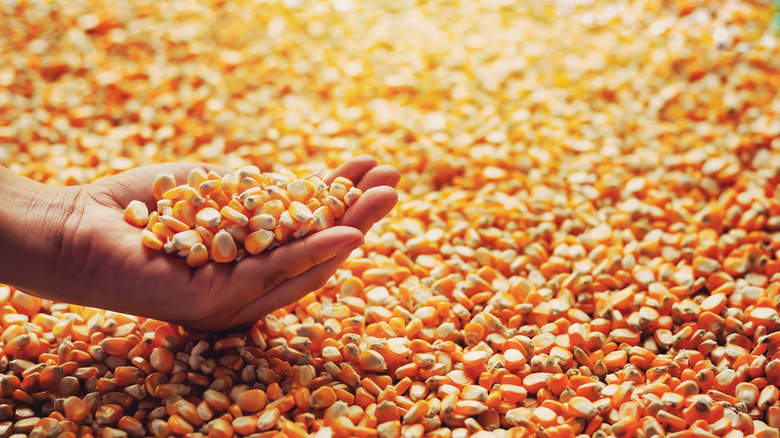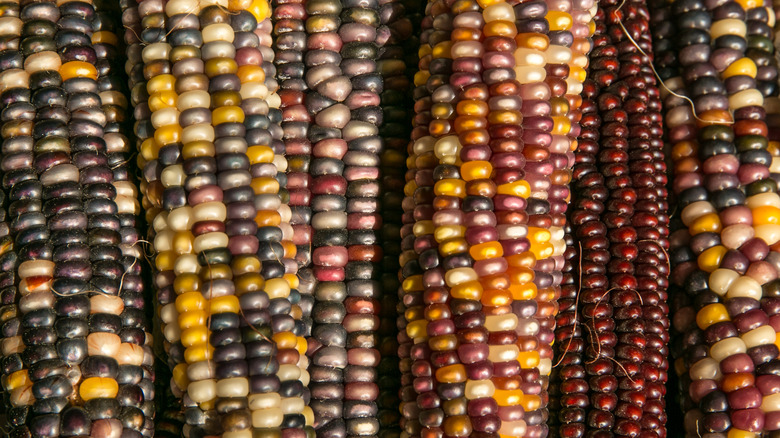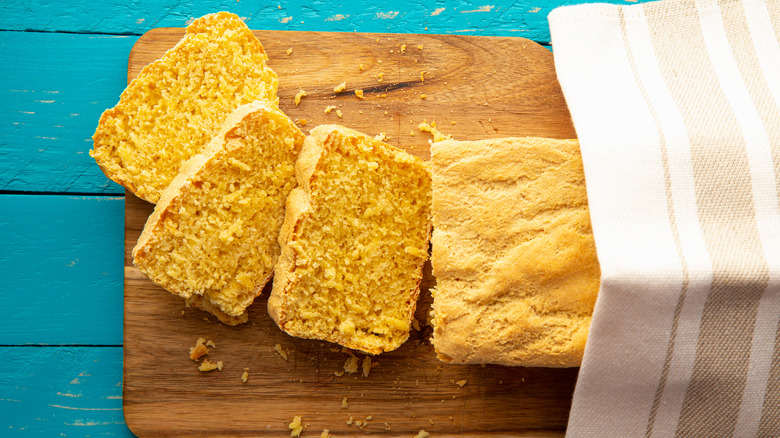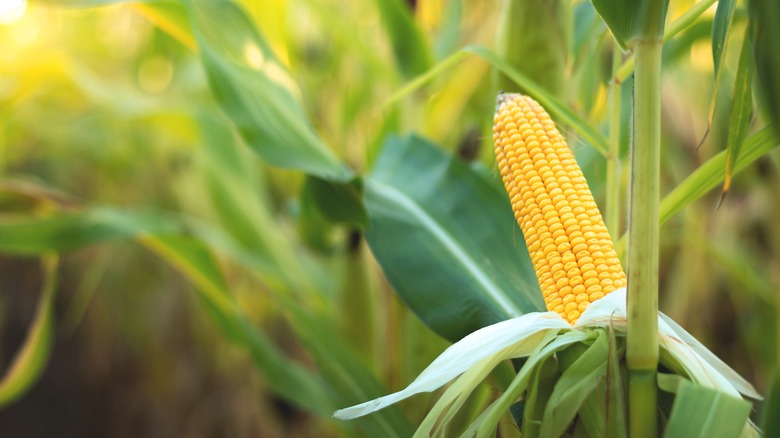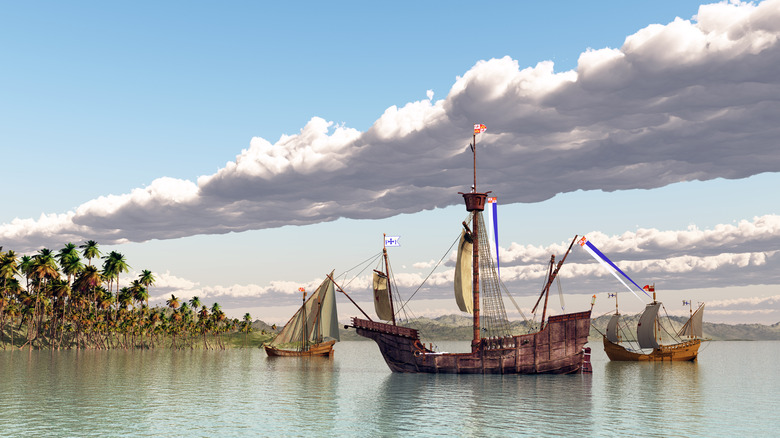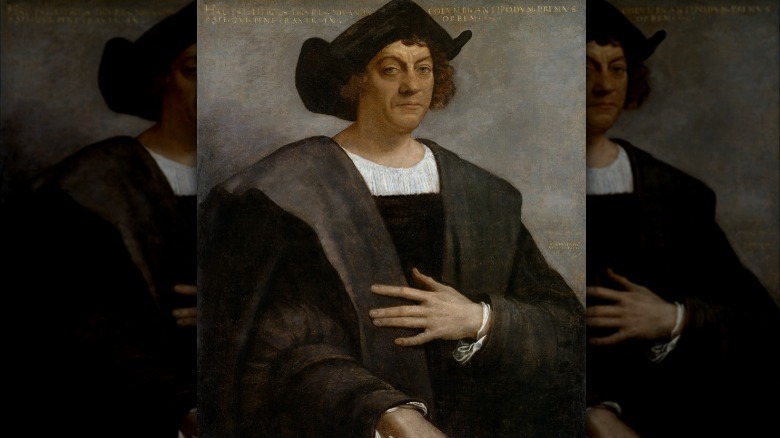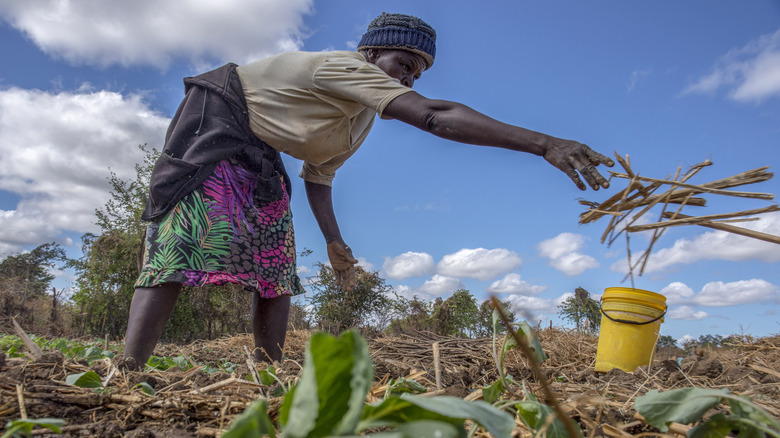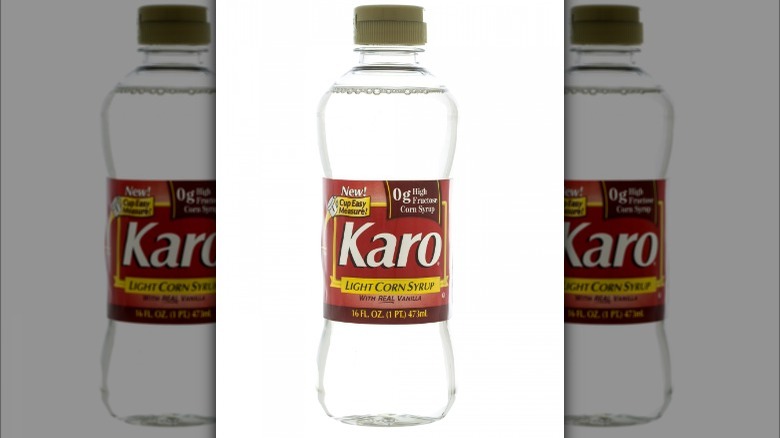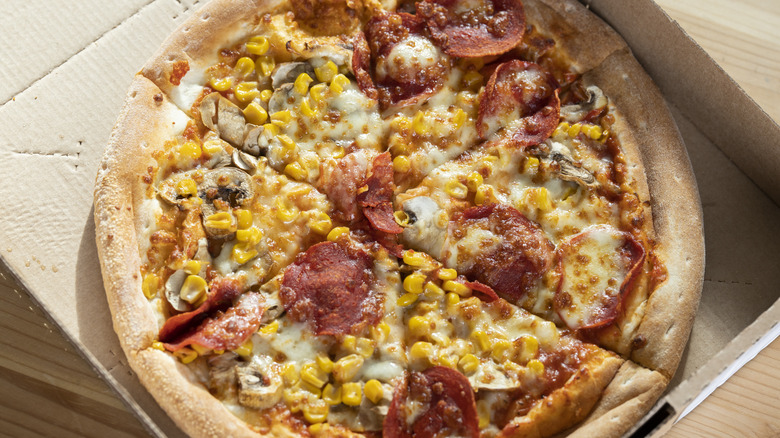The Fascinating Ancient History Of Corn
Corn is a global staple: Across the world, the bright yellow grain has made a name for itself in countless languages and found home in numerous diets. While corn may not be known as health food nowadays, it would be a mistake to write it off as not nutritious. After all, according to Mayo Clinic Health System, corn is fibrous, contains essential minerals, and won't spike blood pressure.
Corn can be used in so many ways. It can be sweet, savory, and juicy. It can be pounded into tortillas, whipped into puddings and breads, or just eaten straight off the cob. There's not much this product can't do, so it's no surprise that it's so popular globally. In the United States specifically, it is commonplace. What would barbecues be without corn on the cob? What we would munch on at the movies? Or even string up on the Christmas tree? Corn is just so common that it's probably hard to imagine life without it. American cuisine is one that has corn in it, darn it!
But, there was indeed, for much of the world, a time without corn. Cultivated since ancient times, corn has a long and winding history that spans across time and the world. There's a fascinating history to this grain — and an exciting future.
The initial domestication of corn
Smithsonian Magazine was not hyperbolic when describing corn as one of the most important crops in the world. Its significance to many different cuisines and diets is not hard to see. But for those who are still doubtful, according to Statista, the world produced over 1.2 billion metric tons of corn in 2021. The U.S. led the pack as both the world's largest corn exporter and consumer.
But this wasn't always the case. Originally, North America didn't cultivate corn, much less consume it. It's in Mesoamerica that corn has its origins, in what is now Mexico to be exact. Also known as maize, it is believed that the crop was first domesticated some 9,000 years ago. While it was believed for a long time that modern corn has one shared ancestor, recent studies, like those reported by The Smithsonian Magazine, indicate that corn's history is actually multi-faceted. There is now a theory that corn was domesticated independently by several groups of people, including in areas of South America. Either way, all modern corn is ultimately a descendant of a wild grain from Southern Mexico called teosinte.
The further evolution and domestication of corn
To paraphrase an agricultural expert at the Cold Spring Harbor Laboratory, what defines humans is our ability to share knowledge. It's crucial to our adaptation and survival that we carry information that could potentially be useful when shared. While the global export of corn came much later, it's important to acknowledge the intra-American export and adaptation of corn that predated it.
Smithsonian Magazine points to an initial southward migration of the crop from Mexico, but corn also eventually came up North. The National Park Service notes that archaeologists have found evidence of corn cultivation in North America dating back as far back as 5,000 years. North American Indian communities intentionally bred corn by fertilizing it with pollen and using specific means of cultivation to create varieties that were suited to the climate. Corn was incredibly important to Native American cuisine, and it was this deep understanding of corn that would be imparted to European colonists. According to Professor Dr. Mary Beth Norton in an interview with Mashed, corn was as an absolute staple in the diet in this region and often the key to survival. In North America, both in indigenous and colonizer communities, corn was often baked into breads and puddings.
The cultural meaning of corn in indigenous society
But, as often with food, there was just as much a cultural meaning to corn as there was a physical need for it. Corn wasn't just a means of survival — it could just as well be a tool of expression. As corn became a staple crop of American society from North to South America, it's nearly impossible to describe the cultural significance it had across the region. Mayan society, for example, according to The Teacher Friendly Guide, valued corn and gave it a religious significance. The source notes the genesis of humans was, as per Mayan religion, directly linked to corn. Humans were believed to have been born from maize, and there were several gods directly dedicated to the crop.
Today, corn still holds major cultural relevance in Mexico, parts of which were once a part of the Mayan Empire. According to the World Business Council for Sustainable Development, corn endures as a symbol for the nation, both as a link to its long history and to contemporary Mexican cuisine. Up north, in contemporary North American Native American society, corn is still used to produce and construct many goods such as mattress stuffing, dolls, woven baskets.
Slavery and corn harvesting
There's a lot to grapple with in North American history; perhaps surprisingly, some of it involves corn. Corn, of course, was introduced to European colonizers by Native Americans, a people who would later be systematically killed and oppressed in order to found the United States (via The Teacher Friendly Guide). We would also be remiss not to mention the historical relevance of slavery with corn cultivation and harvesting in the States.
As the nation was established, slavery became the cornerstone of food production and security in the newly formed nation. While cotton may be most closely associated with slave-driven harvests, as U.S. History Scene notes, produce, including corn, was widely cultivated using slave labor for a long time. Corn also made up the bulk of the diets of many enslaved people. While corn by and large symbolized abundance in the Americas, often being found in the symbolic cornucopia linked to the States, it also held meaning for the active and violent oppression of large groups of people.
The Columbian Exchange brought corn to Europe
For a large amount of time, corn was a crop exclusive to the Americas. However, in the 16th century, this would come to change, and corn would enter an entirely new stratosphere. As European explorers came to America, they created one of the most meaningful systems of modern globalization. This process has been dubbed the Columbian Exchange. The name itself refers to Christopher Columbus, as the explorer had a significant impact on it through his extensive travels (via Brittanica). The phrase was first coined by the historian Alfred Crosby in 1972. As European explorers came into contact with different peoples and lands, goods began to flow back and forth between Eurasia and the Americas directly for the first time in history.
While the historian asserted that diseases and animals were also spread through the exchange, plants were also a meaningful third addition. After all, it was with this very first time that potatoes and tomatoes came to Europe. Just as notably, corn was included in this exchange. The encyclopedia asserts that corn was likely the most notable plant involved in the exchange, as it dramatically shifted agricultural practices in Eurasia and Africa.
Europeans were hesitant about the new foodstuff
Although corn would eventually completely transform global cuisine, it wasn't initially a hit. Europeans, for example, had some hesitations when the cylindrical and husk-covered foodstuff first arrived from its long journey overseas. According to the National Park Service, corn was first introduced to Western Europe, specifically Spain, as Columbus returned back to his port of origin and financiers, the Spanish monarchy.
As noted by an essay published by SBS News, when Columbus came back from his travels with corn, he brought back absolutely no knowledge of how to process it. This led to a significant delay in the European cultivation, and use, of corn. As information traveled at a much slower rate back in the 16th century, it took a few centuries for Europeans to ever fully embrace the product. To this day, corn consumption in Europe lags notably behind other regions of the world.
Eventually corn came to Asia and Africa as well
While corn initially made it to the Eastern Hemisphere through Spain and hesitated culturally in Europe, the golden crop quite literally transformed agriculture in both Africa and Asia according to Britannica. Corn arrived to Africa as early as the 16th century, but it was really in the 18th century that it exploded in popularity. Farmers from North to South Africa discovered that corn would grow in places no other grains would and could be harvested multiple times a year. Other African staple crops spoiled relatively quickly, but farmers found that once processed or ground into a flour, corn could be stored for an exceptionally long period of time. The site notes that this had dramatic political consequences, as empires could grow and feed their populations easily through corn rations.
Corn spread to China through Spanish and Portuguese colonies that were established in Oceania, i.e. The Philippines and Macau (via Gold Thread). Corn took off in the region and is now eaten boiled, steamed, or roasted. Through trade in China, as well as increased global trade, corn would eventually spread throughout Asia.
Corn has become a vital crop globally and a key player in modern times
It comes as no surprise, given corn's versatility, nutritional benefits, and additional uses in producing animal feed among other products that corn came into global favor between the 16th and 18th century. Today, some 200 to 400 years later, corn persists as a very important global crop. Corn still holds the title in Africa, for example, as a staple crop according to Agrivi. Likewise, in 2020, large swaths of Asia and the Middle East have been reserved for corn cultivation, and corn exports remain at an all-time high with no stagnation in sight (via Grain.org and AgFax).
In modernity, corn proved medically significant in producing the ever-necessary antibiotic penicillin as reported in one study. It would also be impossible to talk about corn in modern times without mentioning the creation of high fructose corn syrup. Popularized in the '70s, high fructose corn syrup has been used widely in American foodstuffs, often controversially (via Clark Street Press). For better or worse, corn has developed, and continues to develop, in the modern world.
Corn is finding new meaning in a classic food
Forget about pineapple on pizza, there are bigger fish to fry, or rather corn cobs to husk. Yes, if you're catching our drift, it's true: There are people who are putting corn kernels on pizza. According to Vice, people around the world are beginning to add those golden nuggets to the classic comfort food. It seems almost like food fusion in the worst the way to sprinkle sweet corn on a good slice of pizza. After all, it's one thing to have sweet pineapple, but to bring corn into the mix? Where should the line be drawn?
But, there may be a meaning to the madness, and corn pizza is doing relatively well outside of the U.S. Domino's Japan, for instance, has multiple corn pizza options. The experts over at Pizza Pilgrims even note that there's a corn pizza in Italy. Called the pizza mimosa, the style of pizza combines sweet corn with prosciutto, mozzarella, and panna de cucina. In lieu of tomato sauce, the pizza uses olive oil. Perhaps if the originators of pizza can be swayed to indulge in a bit of corn on top, maybe there is some goodness in the controversial topping after all.
